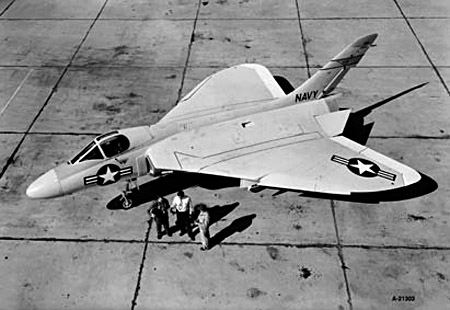Designation:F-40 Skyray (A,C,F,J, T-40) Fighter |
|
||||

|
|||||
|
|
|||||
| Total Length: | 10.21m |
| Total Height: | 3.96m |
| Total Wingspan: | 13.80m |
| Dry Weight | 5,960kg |
The armor on the Skyray is the current state-of-the-art development in low-mass composite-materials Chobham plating that became the standard for all Terran mecha after its application to the VQ-6A Vandal. Aside from the respectable protection provided against projectiles, missiles, and other kinetic weapons, this armor is also resistant to plasma globes (annihilation discs), lasers, and to a lesser extent, particle guns, owing to the fact that the armor can flake off and evaporate in layers under fire from such high-energy weapons, taking much of the weapon's energy and converting it into the latent heat of sublimation in the armor.
The armor stops all small arms fire, heavy infantry weapons fire, and light mecha-mounted weaponry; provides fair resistance to medium mecha-mounted weaponry, such as the Valkyrie's 55mm APFSDS round, and poor resistance to heavy mecha-mounted weaponry, such as the VHT's 105mm smoothbore shells.
The F-40 life support system provides full protection from nuclear, biological, and chemical hazards, using an overpressure cockpit environment activated by radiation and hazardous chemical sensors, or manually when such warfare conditions are anticipated. The internal consumables supplies can provide atmosphere for 36 hours maximum.
During the early stages of the war for lunar independence, the Republican militias included a large number of pilots willing to fly combat missions; however, there were very few aircraft stored serviceable at the Tranquility Sea depot. In fact, the Republican militia and defected military forces would suffer an aircraft shortage during the first year of the struggle. The only two sources of aircraft available were captured vehicles - which were not common - and new construction, which was not possible while the moon was still undergoing liberation.
The only factory capable of producing the fighter craft the fledgling Republic needed was the Teledyne Continental starliner division, located in Isil City. Republican commanders drew up a requirement for a light standard fighter which could support Veritechs in space combat. The fastest way for Teledyne to get a fighter up and running was to copy an existing design. The Luna War Museum was searched for capable airframes that would lend themselves to mass production.
Designers selected one of the few undamaged relics that appeared to hold some promise as an atmospheric fighter. A misidentified Vought F5D Skylancer, thought to be an example of the earlier Vought F4D Skyray, became the Republic's first new aircraft to enter service. The original Skylancer had been designed for the United States Navy, but rejected on political considerations rather than performance.
Teledyne completely dismantled their sample, analyzing everything on the way. Using the measurements taken, the airframe was copied and tested with a spare Beta turbine and a number of off-the-shelf avionics. It flew surprisingly well; but Teledyne's chief engineer wanted to fully bring the design into the 21st Century, and drew up what would become the production model. He specified a slightly longer cockpit section, in order to store a Cyclone and give the fighter room enough to carry canard foreplanes. He also refined the fuselage; applying a blended wing, resulting in a small amount of extra space for reaction mass and making the aircraft appear similar to its USN Skyray predecessor. A new turbine was sourced from Teledyne's thruster plant, with two-dimensional thrust vectoring. The pilot's vision was increased dramatically by raising the seat two inches and designing a bowless polycarbonate 'bubble' canopy. The Republican Navy F-40 Skyray was well on its way to becoming combat ready.
Unfortunately, tragedy struck during the sixth test flight, almost nine months into the program. While the second prototype was executing atmospheric maneuvers over the Teledyne airfield, an improperly machined turbine bearing caused a catastrophic failure of the turbine; the prototype disintegrated and the test pilot was killed instantly. Undaunted, the designers continued their work and a third prototype was constructed. Republican Navy officers were very impressed at a demonstration flight in the eleventh month of the program, and asked that series production begin immediately.
New aircraft were rolling off the lines rapidly by the end of 2057, and made their presence well known by the end of the war. Given the Skyray's lower cost compared to new Veritech designs, the plane could be and was fielded in quite large numbers against the Establishment. Their performance against airborne and spaceborne enemies was quite impressive.
One of the few drawbacks of the Skyray was that the combat persistence was relatively low. It was possible to carry 60 Starburst missiles maximum; but the Establishment's primary combat mecha, the Alpha Veritech, carried 60 of the more powerful Hammerhead missile, as well as other weapons on external hardpoints. Republican pilots also favored the use of longer range missiles, such as the Stiletto and Diamondback. Only twelve of these could be fitted to a Skyray, before new high-capacity multiple ejector racks could be designed. One feature the Skyray had well in its favor was the installation of a beam cannon; its reliance on a constant energy supply instead of limited ammunition gave the excellent little fighter a boost in combat persistence.
After the Revolution, the Skyray began to take a backseat to newer and more powerful fighters that had been acquired from the defeated Establishment and the new Veritech Tomcats. Still, as they could still be fielded in large numbers, they served quite well as guard fighters for all sizes of ships of the line. Most destroyers carried a squadron of Skyrays at some point during the war with Tirol.
Return to Republic Combat Aircraft Index
Return to Robotech Republican Compendium Home Page
Robotech (R) is the property of Harmony Gold. This document is in no way intended to infringe upon their rights.
Content by Derek Ralph